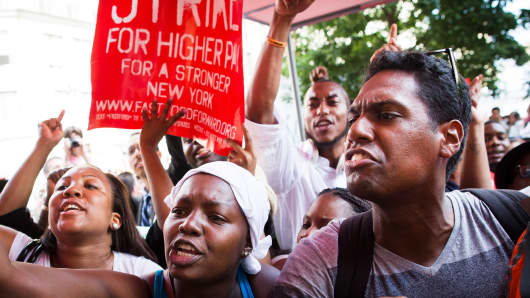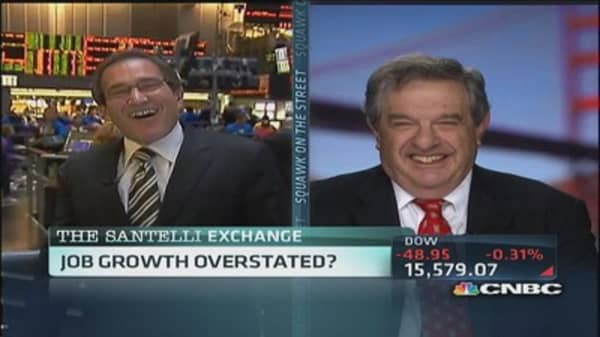Maxie-Collins works in the shoe department for the Chicago Macy's store and recently got a raise and more hours—from $8.25 to $8.50 and from part-time to full-time.
It's a bit of an improvement, but far from enough for her or the other strikers in similar positions.
She joined the strike Thursday, for a day, to protest conditions.
"I was very touched by the fact that so many different people from many different cultures, backgrounds, economic statuses, educational statuses, were here on the strike all having the same problems," he said. "We have the same issue with our jobs, the way we're getting paid, the fact that we're having a difficult time making ends meet with the wages we're getting paid."
The latest jobs report from the government helps exemplify their story.
While the economy added 162,000 jobs in July, wages and hours worked actually edged lower and the job quality remains suspect, even as the unemployment rate ticked lower to 7.4 percent.
(Read more: So-so summer: Job growth disappoints; rate drops)
More than half the positions—85,000 in all—came in either retail jobs like Maxie-Collins' or in the leisure and hospitality industry. That's been a trend repeated month after month in the recovery from the financial crisis and looks unlikely to end soon.
"What we see in the job market reports for the last couple of months just does not tell the story as to what's really going on beneath the surface," said Mike Hard, CEO at BountyJobs.
Hard's firm hosts an online platform that allows companies to manage the use of headhunters—those professional recruiters who help companies fill open positions.
What he sees is a two-speed jobs market: A great one for skilled professionals who already have jobs and are looking to progress up the ladder, and an awful one for those out of work, who haven't been employed in a while and are trying to crack their way back into the labor force.
Companies are expected to spend $8 billion on headhunters in 2014, with the most active industries manufacturing, healthcare, financial services and technology.
(Read more: 5 ways Obama's 'bargain' isn't enough for Main St)
"If you're a passive candidate now, meaning you have five to seven years of experience and you have a job already, the companies are falling all over themselves to find you," Hard said. "If you're actively looking, then there are thousands of people just like you."
That's the story beneath the government jobs numbers—an economy trying to maintain traction while Wall Street stock market indexes like the S&P 500 prosper and Main Street workers struggle.






